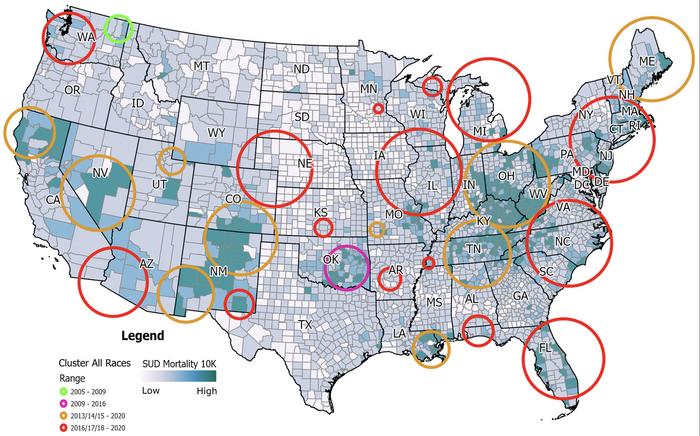The opioid epidemic, a relentless public health crisis, has wreaked havoc, claiming over 665,341 lives across the United States from 2005 to 2020. Recent research from the University of Cincinnati meticulously charts the geographical progression of this tragedy, revealing a significant shift from the Northwest to the East. This profound analysis underscores the evolving nature of addiction and the demographic landscape affected by it. As lawmakers moved to impose stricter regulations on prescription opioids in the mid-2010s, the impact of these policies has become apparent, leading to a resurgence in the use of illicit drugs, notably heroin and synthetic opioids like fentanyl.
Crucially, the research identified a concentrated geographical shift during the period of 2013 to 2016. This was a time marked by stringent legal measures aimed at curbing rampant opioid prescriptions. In the wake of these regulations, individuals grappling with substance use disorders turned increasingly to illicit alternatives. Professor Diego Cuadros of the UC College of Arts and Sciences articulated a vital point: the opioid crisis is not static; it is an evolving epidemic that adjusts in response to societal, legal, and economic factors.
The study’s findings are stark and disconcerting. The demographic affected by substance use disorders has shifted as well. Historically dominated by white populations, the crisis has now infiltrated and devastated many Black communities, particularly in relation to the use of synthetic opioids. Between 2013 and 2016, increased accessibility of synthetic opiates to these communities has been critical in transforming the landscape of addiction. Cuadros highlights that the rising mortality rates among Black individuals indicate a considerable shift in the substance abuse landscape, especially with respect to fentanyl.
Drug overdoses now stand as the leading cause of death among Americans aged 18 to 44. The Centers for Disease Control and Prevention corroborates this alarming trend with comprehensive mortality statistics. The evolving dynamic between supply and demand in the realm of addiction has shown that as the landscape of available substances changed, so too did the vulnerabilities of different communities. Santiago Escobar, the lead author of the study, pointed out the crucial determinants influencing mortality rates; the types of substances abused and the means through which they are accessed have fundamentally altered which populations are most severely impacted.
The research team from UC, which has dedicated years to understanding the complexities of the opioid crisis, is committed to uncovering patterns that characterize this ongoing epidemic. Neil McKinnon, a co-author and the president of Central Michigan University, emphasized the significance of recognizing this epidemic as a series of interconnected mini-epidemics. Identifying these hotspots across both rural and urban America can facilitate targeted interventions and inform public health strategies.
Previously, in 2018, this research group pinpointed specific hotspots within Ohio where the opioid crisis was particularly acute. This geographical analysis has expanded nationwide, identifying clusters in various regions suffering from alarmingly high rates of fatal drug overdoses. The evolution of data analysis techniques has enabled researchers to uncover trends that were previously obscured, providing a clearer picture of how this epidemic unfolds over time.
In an unexpected pivot, Cuadros and his team also focused their efforts on understanding the impact of the COVID-19 pandemic on substance use disorders. COVID-19 has proven to be a unique epidemiological challenge, characterized by the emergence of various variants that have influenced infection rates and mortality. Cuadros drew a parallel between COVID-19 and the opioid crisis, illustrating that both represent complex and dynamic epidemics that evolve rapidly due to changing social conditions.
The opioid epidemic is marked by its complexity, necessitating multi-faceted approaches to address the underlying issues. The results from UC’s research serve as a crucial resource for public health officials and policymakers who are striving to formulate effective strategies to combat not only the opioid crisis but also the broader challenges associated with substance use disorders. Understanding the nuances of this epidemic is critical; policymakers must take into account the shifting demographics, types of substances, and geographical areas most affected.
As this critical research is disseminated through prestigious platforms such as The Lancet Regional Health — Americas, there is hope that it will inform future public health policies and interventions. The need for a systematic and data-driven approach to understanding the opioid epidemic is more pressing than ever. Tracking emerging trends and hotspots can empower communities to allocate resources effectively, ensure that vulnerable populations receive the help they need, and ultimately pave the way toward prevention and recovery.
The complexity of substance use disorders and their evolving patterns necessitate ongoing research and dialogue within the medical community. By closely monitoring trends and understanding the factors contributing to these changes, healthcare providers and policymakers can work collaboratively to create a more holistic and effective response to the crisis at hand.
In conclusion, the ongoing struggles faced by those affected by substance use disorders — as well as the shifts in demographic and geographic patterns — highlight the urgent need for comprehensive public health strategies that not only address the symptoms of this epidemic but also tackle its underlying causes. By understanding the opioid epidemic’s multifaceted nature, stakeholders can better serve affected communities and work toward a healthier, more sustainable future for all.
Subject of Research: People
Article Title: Spatiotemporal analysis of substance use disorder mortality in the United States: an observational study of emerging hotspots and vulnerable populations
News Publication Date: 9-Apr-2025
Web References: The Lancet
References: DOI 10.1016/j.lana.2025.101075
Image Credits: Credit: UC DIGITAL EPIDEMIOLOGY LAB
Keywords: Opioids, substance abuse, addiction, epidemiology, fentanyl, public health, demographics




